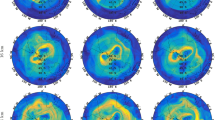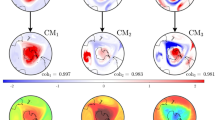Abstract
The present paper examines the vortex breakdown and large-scale stirring during the final warming of the Southern Hemisphere stratosphere during the spring of 2005. A unique set of in situ observations collected by 27 superpressure balloons (SPBs) is used. The balloons, which were launched from McMurdo, Antarctica, by the Stratéole/VORCORE project, drifted for several weeks on two different isopycnic levels in the lower stratosphere. We describe balloon trajectories and compare them with simulations obtained on the basis of the velocity field from the GEOS-5 and NCEP/NCAR reanalyses performed with and without VORCORE data. To gain insight on the mechanisms responsible for the horizontal transport of air inside and outside the well-isolated vortex we examine the balloon trajectories in the framework of the Lagrangian properties of the stratospheric flow. Coherent structures of the flow are visualized by computing finite-time Lyapunov exponents (FTLE). A combination of isentropic analysis and FTLE distributions reveals that air is stripped away from the vortex’s interior as stable manifolds eventually cross the vortex’s edge. It is shown that two SPBs escaped from the vortex within high potential vorticity tongues that developed in association with wave breaking at locations along the vortex’s edge where forward and backward FTLE maxima approximately intersect. The trajectories of three SPBs flying as a group at the same isopycnic level are examined and their behavior is interpreted in reference to the FTLE field. These results support the concept of stable and unstable manifolds governing transport of air masses across the periphery of the stratospheric polar vortex.






Similar content being viewed by others
References
Reinecker MM et al (2007a) The GEOS-5 data assimilation system: a documentation of GEOS-5.0, in Tech. Rep. 104606 V27, NASA. Internal communication
Beron-Vera FJ, Brown MG, Olascoaga MJ, Rypina II, Koçak H, Udovychenkov IA (2008) Zonal jets as transport barriers in planetary atmosphere. J Atmos Sci 65:3316–3326
Boccara G, Hertzog A, Basdevant C, Vial F (2008a) Accuracy of NCEP/NCAR reanalyses and ECMWF analyses in the lower stratosphere over Antarctica in 2005. J Geophys Res. doi:10.1029/2008JD010116
Boccara G, Hertzog A, Vincent RA, Vial F (2008b) Estimation of gravity-momentum flux and phase speeds from quasi-Lagrangian stratospheric balloon flights. 1: theory and simulations. J Atmos Sci 65:3042–3055
Bowman KP (1993) Large-scale isentropic properties of the Antarctic polar vortex from analyzed winds. J Geophys Res 98:23013–23027
Bowman KP (1996) Rossby wave phase speeds and mixing barriers in the stratosphere. Part I: observations. J Atmos Sci 53:905–916
Bowman KP, Pan LL, Campos T, Gao R (2007) Observations of fine-scale transport structure in the upper troposphere from the high-performance instrumented airborne platform for environmental research. J Geophys Res 112:D18111. doi:10.1029/2007JD008685
Charlton AJ, O’Neill A, Lahoz WA, Berrisford P (2005) The splitting of the stratospheric polar vortex in the Southern Hemisphere, September 2002: dynamical evolution. J Atmos Sci 62:590–602
d’Ovidio F, Fernández V, Hernández-García E, López C (2004) Mixing structures in the Mediterranean Sea from finite-size Lyapunov exponents. Geophys Res Lett 31:L17203. doi:10.1029/2004GL020328
Dritschel DG, McIntyre ME (2008) Multiple jets as PV staircases: the Phillips effect on the resilience of eddy-transport barriers. J Atmos Sci 65:855–874
Dvorkin Y, Paldor N, Basdevant C (2001) Reconstructing balloon trajectories in the tropical stratosphere with a hybrid model using analysed fields. Q J R Meteorol Soc 127:975–988
Farman JC, Gardiner BG, Shanklin JD (1985) Large losses of total ozone in Antarctica reveal seasonal ClO x /NO x interaction. Nature 315:207–210
Haller G (2002) Lagrangian coherent structures from approximate velocity data. Phys Fluids 14:1851–1861
Haller G, Poje AC (1998) Finite time transport in aperiodic flows. Phys D 119:352–380
Hertzog A, Vial F, Mechoso CR, Basdevant C, Cocquerez P (2002) Quasi-Lagrangian measurements in the lower stratosphere reveal an energy peak associated with near-inertial waves. Geophys Res Lett 29:1229. doi:10.1029/2001GL014083
Hertzog A, Basdevant C, Vial F, Mechoso CR (2004) The accuracy of stratospheric analyses in the Northern Hemisphere inferred from long-duration balloon flights. Q J R Meteorol Soc 130:607–626
Hertzog A, Cocquerez P, Basdevant C, Boccara G, Bordereau J, Brioit B, Cardonne A, Guilbon R, Ravissot A, Schmitt E, Valdivia JN, Venel S, Vial F (2007) Strateole/VORCORE—long-duration, superpressure balloons to study the Antarctic lower stratosphere during the 2005 winter. J Atmos Oceanic Technol 24:2048–2061
Hertzog A, Boccara G, Vincent RA, Vial F (2008) Estimation of gravity–momentum flux and phase speeds from quasi-Lagrangian stratospheric balloon flights. 2: results from the VORCORE campaign in Antarctica. J Atmos Sci 65:3056–3070
Hoskins BJ, McIntyre ME, Robertson AW (1985) On the use and significance of isentropic potential vorticity maps. Quart J R Meteorol Soc 111:877–946
Joseph B, Legras B (2002) Relation between kinematic boundaries, stirring, and barriers for the Antarctic polar vortex. J Atmos Sci 59:1198–1212
Juckes NM, McIntyre ME (1987) A high-resolution one-layer model of breaking planetary waves in the stratosphere. Nature 328:590–596
Kalnay E et al (1996) The NCEP/NCAR 40-year reanalysis project. Bull Am Meteorol Soc 77:437–471
Koh T-Y, Legras B (2002) Hyperbolic lines and the stratospheric polar vortex. Chaos 12:382–394
Koh T-Y, Plumb RA (2000) Lobe dynamics applied to barotropic Rossby-wave breaking. Phys Fluids 12:1518–1528
Legras B, Pisso I, Berthet G, Lefèver F (2005) Variability of the Lagrangian turbulent diffusion in the lower stratosphere. Atmos Chem Phys 5:1605–1622
Lehahn Y, d’Ovidio F, Léyy M, Heifetz E (2007) Stirring of the northeast Atlantic spring bloom: a Lagrangian analysis based on multisatellite data. J Geophys Res 112:C08005. doi:10.1029/2006JC003927
Mariotti A, Mechoso CR, Legras B, Daniel V (2000) The evolution of the ozone “collar” in the Antarctic lower stratosphere during early August 1994. J Atmos Sci 57:402–414
Mechoso CR, O’Neill A, Pope VD, Farrara JD (1988) A study of the stratospheric final warming of 1982 in the southern hemisphere. Q J R Meteorol Soc 114:1365–1384
Newman PA (1986) The final warming and the polar vortex disappearance during the Southern Hemisphere spring. Geophys Res Lett 13:1228–1231
Polvani LM, Plumb RA (1992) Rossby wave breaking, microbreaking, filamentation and secondary vortex formation: the dynamics of a perturbed vortex. J Atmos Sci 49:462–476
Rypina II, Brown MG, Beron-Vera FJ, Koçak H, Olascoaga MJ, Udovydchenkov IA (2007a) On the Lagrangian dynamics of atmospheric zonal jets and the permeability of the stratospheric polar vortex. J Amos Sci 64:3595–3610
Rypina II, Brown MG, Beron-Vera FJ, Koçak H, Olascoaga MJ, Udovydchenkov IA (2007b). Robust tranport barriers resulting from strong Kolmogorov–Arnold–Moser stability. Phys Rev Lett 98:104102. doi:10.1103/PhysRevLett.98.104102
Shadden SC, Lekien F, Marsden JE (2005) Definition and properties of Lagrangian coherent structures from finite-time Lyapunov exponents in two-dimensional aperiodic flows. Phys D 212:271–304
Trounday B, Perthuis L, Strebelle S, Farrara JD, Mechoso CR (1995) Dispersion properties of the flow in the southern stratosphere during winter and spring. J Geophys Res 100:13901–13917
Vial F, Hertzog A, Mechoso CR, Basdevant C, Cocquerez P, Dubourg V, Nouel F (2001) A study of the dynamics of the equatorial lower stratosphere by use of ultra-long-duration balloons, 1: planetary scales. J Geophys Res 106:22725–22743
Waugh DW, Abraham ER (2008) Stirring in the global surface ocean. Geophys Res Lett 35:L20605. doi:10.1029/2008GL035526
Waugh DW, Plumb RA (1994) Contour advection with surgery: a technique for investigating finescale structure in tracer transport. J Atmos Sci 51:530–540
Yamazaki K, Mechoso CR (1985) Observations of the final warming in the stratosphere of the Southern Hemisphere during 1979. J Atmos Sci 42:1198–1205
Acknowledgments
The authors especially thank Andrew V. Tangborn, from the National Aeronautics and Space Administration (NASA), for providing with the GEOS5 data and Lynette J. Gelinas for helpful discussion. The authors are also grateful to the two anonymous reviewers for their constructive and useful comments that help improve the manuscript. VORCORE was jointly supported by Centre National de la Reserche Scientifique (CNRS), France, the Centre National d’Études Spatiales (CNES), France, and the National Science Foundation (NSF), USA. The research was supported by NSF Grant ATM—0732222 and by Office of Naval Research Grants N00014040191 and N000140910418 and by the Spanish Ministry of Science and Innovation project CGL2008-06295.
Author information
Authors and Affiliations
Corresponding author
Rights and permissions
About this article
Cite this article
de la Cámara, A., Mechoso, C.R., Ide, K. et al. Polar night vortex breakdown and large-scale stirring in the southern stratosphere. Clim Dyn 35, 965–975 (2010). https://doi.org/10.1007/s00382-009-0632-6
Received:
Accepted:
Published:
Issue Date:
DOI: https://doi.org/10.1007/s00382-009-0632-6




